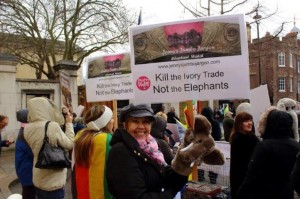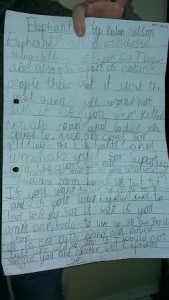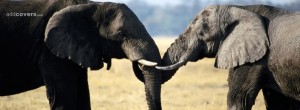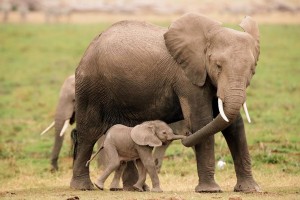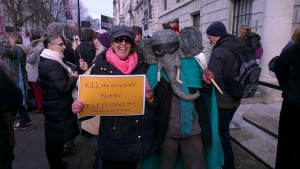1979 – The elephant population was 1.3 million.
2014 – We see a figure of 500 000 being bandied about. How long will these soulful animals leave their footprints on the sand when a 100 are being slaughtered per day? Are elephants being poached faster than they can breed. One elephant every 15 minutes is being slaughtered for its personal treasure ‘white gold’. In layman’s terms: they are being slaughtered for their incisors. What sort of society are we a part of? Tragically, the illegal wildlife trade is enormous. Annually £12 billion ($20 billion US) worth of ill gotten gains is butchered from these sentient (my poem) creatures leaving the putrefying stench of rotting flesh in their wake. WHAT FOR?
95% of the Democratic Republic of the Congo’s forests are devoid of elephants.’ What for? I know, I am repeating myself. Sadly what collectors call ‘white gold’ represents wealth and nobleness for the Chinese people. What does a tragic misconception like this mean to the elephants? DEATH. The lust for ivory that puts Chinese people in a class of their own is for these charismatic creatures, a death warrant. The bush, the elephants home has become a battlefield, and they are often slaughtered in the cruelest and most primitive ways.
Despite the global ban in 1989, the illegal ivory business is flourishing. Beijing’s ‘elephant graveyard’ shows how China is still in the driving seat, and these people hold the destiny of the African elephants in their hands. Hot on China’s heels is the USA who have now implemented a ban on commercial ivory which I hope will set a precedent for other countries to follow.
Hong Kong is a key transit point for ivory and other illegal wildlife entering from Africa on route to destinations which include Philippines, Vietnam, Taiwan and Malaysia. Hong Kong has however declared it is in the forefront in the fight to halt the ivory trade, and has shown it’s support by announcing it will destroy 28 tonnes of seized ivory. This is all good news for elephants?
The ‘blood ivory’ trade has reached such alarming proportions that Governments from around the globe are being urged to go into ‘battle’ against the illegal trade. Prince Charles and Prince William hosted a two day summit in London last week which was attended by decision makers from 46 countries. I joined the throng of animal lovers outside to show our relief and support that this positive action had brought so many countries together.
Now, as an animal/elephant lover and as a responsible custodian of our wildlife, I want action, and we want it now before it is too late. I am hoping that this landmark agreement to halt wildlife trafficking is just a beginning. With so few elephants remaining, it is a fight we all need to concentrate on. Once these sentient beings are gone, they are gone. For those who can afford to buy ivory, take that money and go and visit the last few remaining countries where these magnificent creatures roam. Kenya, South Africa, Tanzania and Zimbabwe: to and see them in the wild and fall in love with them. You too can become a voice for the voiceless as we change our outlook on ivory. Fighting wildlife crime can no longer be viewed in isolation: some of it is linked to terrorism, which is funded by ‘blood ivory’. In many instances, it has become a case of killing elephants to fund killing people. To me, it all seems a little obscene.
You as a consumer, a thinking consumer can decide the fate of these soulful creatures: it is as easy as the choice TO BUY or NOT TO BUY. As a consumer of ivory, your demand for the product is responsible for not only the death of elephants, but also the collapse of elephant society brought on by extensive poaching. Elephants transmit elephant cultures from one generation to the next. Echoes of harmony are quickly lost as survivors of poaching incidents are left traumatised and rudderless. Elephants are close knit and emotional creatures with strong family bonds. What we see in behavioral patterns with elephants after a ‘genocide’ is frighteningly close to how humans react. Let us not be the ones who destroy this magnificent species.



